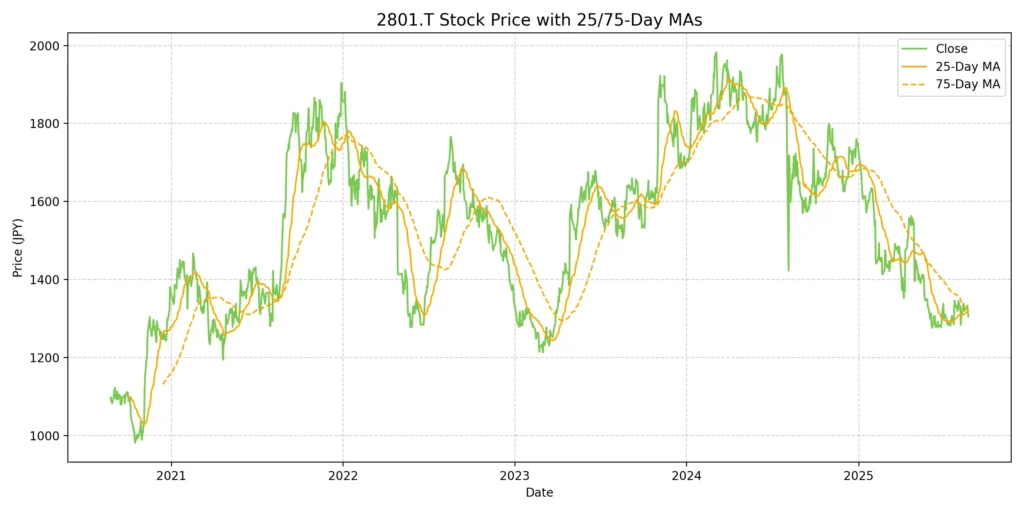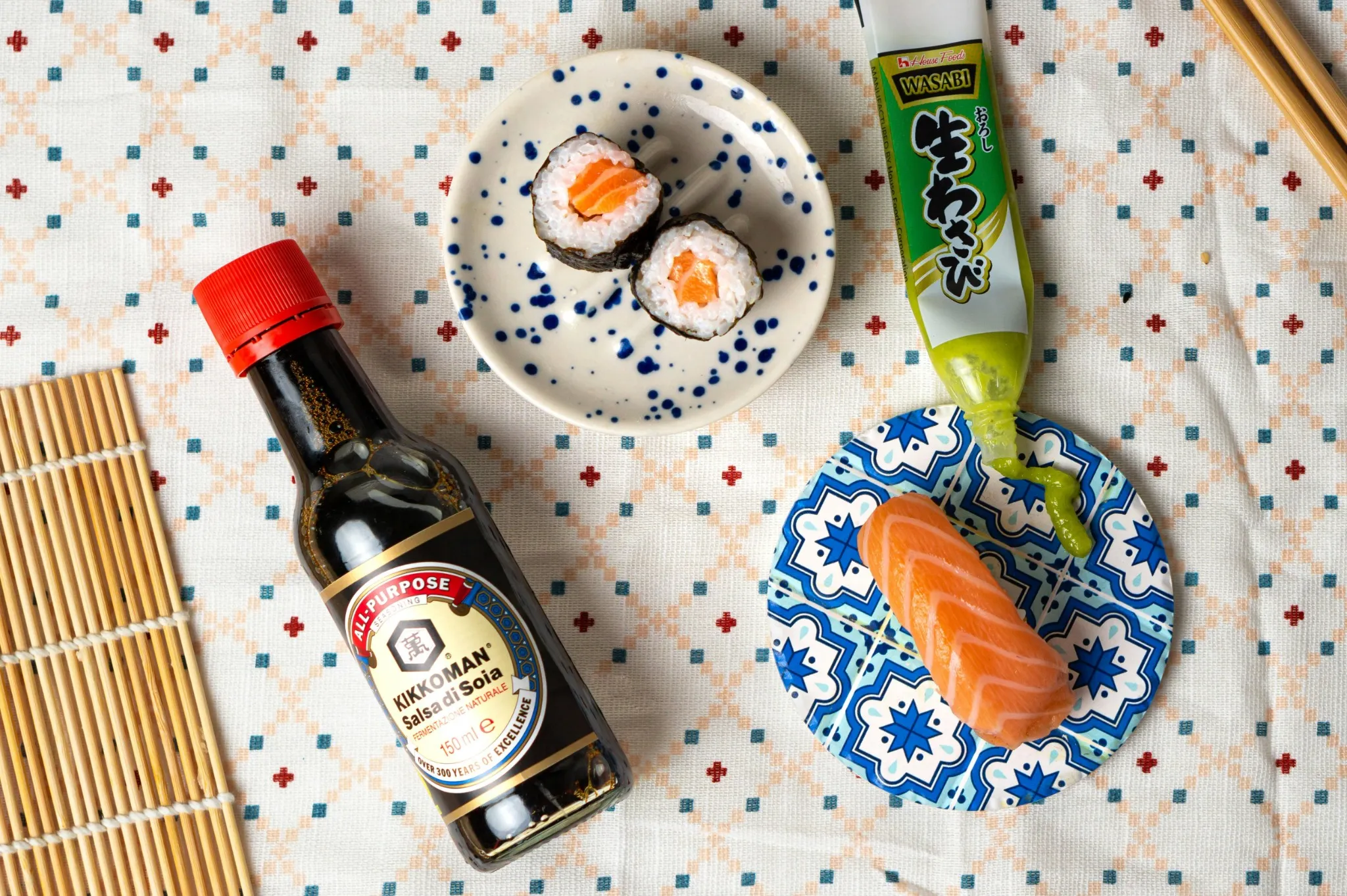Kikkoman Corporation (TSE: 2801): Stock Analysis
August 25, 2025

1. Executive Summary
Kikkoman Corporation (TSE: 2801) is the world’s leading soy sauce brand, generating over 75% of its revenue from overseas markets. The company delivered consistent top- and bottom-line growth from FY2023 to FY2025, supported by strong overseas demand, pricing power, and a disciplined cost structure. In FY2025, revenue reached ¥709.0 billion and net profit ¥61.7 billion—both record highs.
Despite a softer Q1 in FY2026 due to yen appreciation and U.S. wholesale normalization, Kikkoman maintained its full-year guidance, signaling confidence in the business outlook. At the current share price of ¥1,311, the stock trades at ~20.2x FY2025 earnings, slightly below its historical average.
While short-term currency and cost pressures remain, Kikkoman’s combination of global brand strength, stable cash flow, and expanding dividend policy may appeal to investors seeking long-term exposure to the international food sector.
2. Financial Performance (FY2023–FY2025)
Kikkoman delivered steady revenue and profit growth over the past three years, supported by expanding overseas demand, product mix improvements, and operational efficiency. The company also increased shareholder returns during this period, although the FY2025 dividend included a non-recurring special component.
| Fiscal Year End | Revenue (¥ bn) | Operating Profit (¥ bn) | Net Profit (¥ bn) | EPS (¥) | DPS (¥) |
|---|---|---|---|---|---|
| FY2023 (Mar 2023) | 618.9 | 55.4 | 43.7 | 45.7 | 15.6 |
| FY2024 (Mar 2024) | 660.8 | 66.7 | 56.4 | 59.2 | 20.8 |
| FY2025 (Mar 2025) | 709.0 | 73.7 | 61.7 | 65.0 | 25.0* |
Key Observations:
Revenue rose from ¥618.9 billion to ¥709.0 billion over three years (+14.5%), driven mainly by strong growth in the U.S. soy sauce and food wholesale businesses.
Operating profit grew steadily each year, reaching ¥73.7 billion in FY2025 (+33.0% from FY2023).
Net profit expanded by over 40% during the same period, reflecting better cost controls and FX tailwinds.
EPS increased from ¥45.7 to ¥65.0, in line with earnings growth.
Dividends per share (DPS) rose each year, with FY2025 reaching ¥25.0—which includes a ¥2.0 special dividend to commemorate the company’s 105th anniversary and global expansion achievements.
While the DPS increase in FY2025 reflects stronger shareholder returns, part of the rise was non-recurring. Future dividends will depend on earnings sustainability and capital allocation priorities.
Source:
Company Annual Securities Reports (2023–2025)
Shikiho (June 2025 edition, Toyo Keizai)
Kikkoman Fact Book FY2025
* Includes a ¥2.0 special dividend in FY2025
3. Segment Performance and Business Drivers
Kikkoman’s business is broadly divided into two core segments:
Production and Sales of Food Products (primarily soy sauce and seasonings)
Wholesale Business (via subsidiaries like JFC Group)
The company also categorizes results by geographic regions, each contributing differently to revenue and profitability.
3.1 Revenue Breakdown by Region (FY2025)
| Region | Revenue (¥ bn) | YoY Growth | Share of Total Revenue |
|---|---|---|---|
| North America | 379.9 | +7.1% | 53.6% |
| Europe | 79.8 | +13.1% | 11.3% |
| Asia/Oceania | 72.3 | +4.7% | 10.2% |
| Japan | 177.0 | +2.8% | 25.0% |
| Total | 709.0 | +7.3% | 100% |
3.2 Operating Profit by Region (FY2025)
| Region | Operating Profit (¥ bn) | YoY Growth |
|---|---|---|
| Overseas Total | 64.0 | +7.3% |
| North America | 43.6 | +6.9% |
| Europe | 10.8 | +15.8% |
| Asia/Oceania | 9.6 | +2.4% |
| Japan | 9.7 | –6.6% |
| Total | 73.7 | +10.4% |
3.3 Key Business Drivers
North America: Growth Engine
Largest revenue and profit contributor.
U.S. soy sauce business maintained double-digit growth in local currency.
JFC wholesale business showed solid recovery post-COVID, aided by demand from foodservice sectors.
FX gains (USD/JPY ~152.5 in FY2025) supported strong yen-denominated profit.
Europe: Improving Margins
Soy sauce and Asian food categories continue to expand in Germany, UK, and Nordic countries.
Operating margin improved due to favorable product mix and cost efficiency.
Asia/Oceania: Early-stage Growth
Steady growth in Australia, Singapore, and Malaysia.
New market development efforts are ongoing in Southeast Asia and India.
Japan: Margin Pressure
While sales grew modestly (especially in beverages), operating profit declined.
Higher logistics and packaging costs eroded margins.
Strategy shifting toward value-added products and premium seasonings.
3.4 Strategic Focus
Localization of production in the U.S. and Europe to hedge FX and tariff risks.
Digital transformation (DX) and supply chain optimization underway, especially in domestic logistics.
Continued investment in brand positioning and health-focused products across global markets.
4. Market Position and Competitive Landscape
Kikkoman is the most globally dominant and widely recognized soy sauce brand, with operations in over 100 countries and production facilities across Asia, North America, and Europe. Its global leadership is supported by decades of investment in branding, localization, health-oriented product innovation, and resilient supply chain infrastructure. While the company leads the market, it faces targeted competition in specific regions and categories.
4.1 Global Soy Sauce Market Position
Kikkoman holds the largest global market share in soy sauce, especially in North America where it commands a dominant position in both retail and foodservice. Its extensive overseas production network and deep brand loyalty are key competitive advantages.
| Company | Region Focus | Soy Sauce Market Share (Est.) | Brand Perception | Production Locations |
|---|---|---|---|---|
| Kikkoman | Global (U.S., EU, Asia) | #1 worldwide (70–80% in U.S.) | Premium, authentic, global | Japan, U.S., Netherlands, Singapore, China |
| Yamasa | Japan, U.S. West Coast | ~10–15% (U.S.) | Traditional, rich flavor | Japan, U.S. |
| Lee Kum Kee | China, Global | Leader in Chinese sauces | Affordable, diversified | China, Malaysia, U.S. |
| Ajinomoto | Global | Broader product scope | R&D strength, umami leader | Japan, Asia, Americas |
4.2 Strategic Differentiation
Kikkoman’s competitive moat is built on:
Global Brand Recognition: Its name is virtually synonymous with soy sauce in many Western markets, reflecting decades of investment in education and positioning.
Health-Oriented Innovation: The company leads in low-sodium, gluten-free, and organic soy sauce offerings, especially in Europe and the U.S.
Localized Production: Regional manufacturing allows for faster delivery, cost control, and tariff mitigation.
Product Expansion: Kikkoman leverages its brand to offer sauces, marinades, and beverages beyond traditional soy sauce.
4.3 Domestic Landscape and Positioning
In Japan, Kikkoman maintains market leadership but faces rivalry from companies like Yamasa and other traditional brands. However, its differentiation is clear:
Stronger retail and export networks
Premium product development (e.g., “nama-shoyu”)
Higher-margin functional and health-positioned lines
Moreover, Higeta Shoyu, once perceived as a local competitor, is now effectively a group-related company and does not pose strategic competition.
4.4 Competitive Risks
While Kikkoman’s brand and global scale are unmatched, several risks remain:
Private-label encroachment in supermarkets, particularly in the U.S. and Europe
FX exposure, as most profits are earned abroad but reported in yen
Local competitors in emerging markets offering regionally tailored sauces at lower prices
Slower growth in Japan, where demographic challenges and cost inflation persist
4.5 Summary
Kikkoman’s market position is well-defended through a combination of global scale, premium branding, localized manufacturing, and innovation leadership. Unlike regional or domestic competitors who either lack global reach or brand equity, Kikkoman operates as a true international consumer staple with deep roots and expanding growth avenues.
5. Risks and Catalysts
Kikkoman’s long-term fundamentals remain strong, but investors should be aware of both structural risks and near-term catalysts that may affect the company’s earnings visibility and share price trajectory.
5.1 Key Risks
Foreign Exchange Volatility
Over 75% of Kikkoman’s revenue and operating profit is generated overseas, making its results highly sensitive to currency fluctuations.
A strengthening yen, particularly against the U.S. dollar and euro, could reduce the yen-denominated value of overseas earnings.
Example: In Q1 FY2026, a stronger JPY/USD rate (~145 vs 152.5 YoY) resulted in a –11% drop in operating profit, despite stable underlying demand.
Raw Material and Packaging Costs
Kikkoman is exposed to global commodity inflation, particularly for soybeans, wheat, salt, sugar, PET bottles, and logistics.
While the company has passed on some of the costs via price increases, persistent inflation may pressure margins, especially in the Japanese beverage and domestic seasoning segments.
Domestic Market Saturation
Japan accounts for ~25% of revenue but contributes a disproportionately lower share of profit.
Demographic decline, intensified competition, and cost rigidity in the domestic market limit upside potential.
FY2025 showed a –6.6% YoY decline in Japan segment operating profit, despite top-line growth.
Private-Label Competition (North America & EU)
Retailers in the U.S. and Europe continue to expand their own private-label Asian sauces, offering lower-priced alternatives to Kikkoman.
While brand loyalty is high, prolonged economic pressures may erode consumer preference for premium-priced products.
Geopolitical and Trade Risks
The company operates manufacturing sites in China, the U.S., the Netherlands, and Singapore.
Tariffs, trade policy shifts (e.g., U.S.–China tensions), or regulatory barriers could disrupt supply chains or increase cost structures.
5.2 Catalysts for Future Growth
Global Health and Wellness Trends
Kikkoman’s low-sodium, gluten-free, and organic products are well-aligned with long-term shifts in global dietary preferences.
Europe and North America show continued demand for health-positioned food products.
Expansion in Emerging Markets
Penetration into Southeast Asia, India, and Latin America represents long-term upside potential.
The company is investing in local marketing and distribution partnerships to accelerate growth.
Supply Chain Localization and DX
Continued investment in regional production facilities improves efficiency and resilience.
Digital transformation (DX) initiatives, particularly in logistics and customer interface, could enhance profitability in the domestic market.
Stable Free Cash Flow and Dividend Policy
Kikkoman has a robust balance sheet, minimal debt, and growing free cash flow.
With a payout ratio now exceeding 50%, the company offers increasing shareholder returns.
Special dividends or buybacks remain a possibility in milestone years.
FX Tailwinds (Conditional)
If the yen resumes its weakening trend (e.g., USD/JPY above 150), overseas profits could see a boost in yen terms.
This makes the stock partly attractive as a hedge against yen depreciation for Japanese investors.
5.3 Summary
Kikkoman’s risk profile is balanced by strong operational resilience, global brand equity, and a clear long-term strategy. While short-term profit fluctuations due to FX or cost inflation may continue, the company’s expanding global footprint, health-oriented innovation, and stable dividend policy provide multiple avenues for value creation.
Investors should watch for FX trends, raw material price stabilization, and emerging market expansion as potential near-term re-rating triggers.
6. Conclusion: Is Kikkoman a Buy?
Kikkoman has evolved from a traditional Japanese soy sauce producer into a globally recognized food company, with over 75% of its sales generated outside Japan. Its track record of revenue and profit growth, supported by strategic overseas expansion and product innovation, positions it well in the premium condiment category worldwide.
Between FY2023 and FY2025, Kikkoman achieved:
Revenue growth of +14.5% (¥618.9 bn → ¥709.0 bn)
Operating profit growth of +33% (¥55.4 bn → ¥73.7 bn)
Net income reaching an all-time high of ¥61.7 bn
A rising dividend with a FY2025 payout ratio exceeding 50%
While Q1 FY2026 results showed temporary weakness due to yen appreciation and softer U.S. wholesale demand, the company maintained its full-year guidance. Management expects recovery in later quarters, supported by seasonal consumption, improved logistics, and global retail demand.
Valuation Perspective
As of August 2025, the stock trades at:
¥1,311 per share
~20.2x FY2025 EPS of ¥65.0
Dividend yield of approximately 1.9%, based on a ¥25.0 DPS
This places Kikkoman slightly below its historical valuation average, and at a discount to global food peers like McCormick and Hormel, which trade at 22–25x forward earnings.
While not obviously undervalued, the current price level may offer a reasonable entry point for investors seeking:
Stable global exposure to the food and consumer staples sector
Yen-hedged earnings potential
Long-term dividend growth backed by strong free cash flow
Final Thoughts
Kikkoman may not appeal to short-term momentum traders, but for long-term investors, it offers a rare combination of:
Global brand strength
Operational resilience
Disciplined capital allocation
Shareholder-friendly dividend policy
In that sense, Kikkoman is worth serious consideration for those looking to gain exposure to a globally scalable Japanese company with a defensible business model.
Ultimately, whether Kikkoman is a “buy” depends on your investment horizon and risk tolerance—but the case for inclusion in a long-term, globally diversified portfolio is compelling.
At Wasabi Info, we publish concise equity reports and market insights through our blog, and also provide custom, tailor-made research to support strategic decision-making for both private investors and corporations.
Our research services include:
• Equities: In-depth analysis of Japan-listed companies not featured in the blog
• Competitor Analysis: Detailed mapping of industry rivals and market dynamics
• Market Entry Intelligence: Insights into local barriers, regulations, and competitor positioning
• Real Estate & Assets: Localized assessments for factory, hotel, or retail expansion
• Field Intelligence: On-the-ground surveys and discreet market checks unavailable through public sources
Reports are available in English, Chinese, and Japanese.
For inquiries, please contact: admin@wasabi-info.com
© Wasabi Info | Privacy Policy
Disclaimer
This report is provided for informational purposes only and does not constitute investment, legal, or tax advice.
The analysis may include forward-looking statements and interpretations based on publicly available information as of the date of writing.
Readers are solely responsible for their own investment decisions and should seek advice from a licensed financial advisor or other qualified professional.
Wasabi-Info.com makes no representation or warranty, express or implied, regarding the accuracy, completeness, or reliability of the information contained herein, and shall not be held liable for any loss or damage arising from the use of this report.




